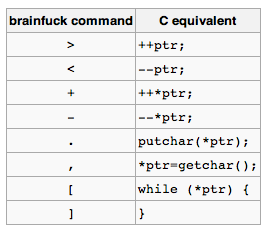bfc.rb is a compiler written in Ruby, which can compile BF code to Ruby, C, Haskell and LLVM.
$ ./bfc.rb --help
$ ./bfc.rb [-v|--version]
$ ./bfc.rb [-r|--ruby] helloworld.bf > helloworld.rb
$ ./bfc.rb [-c|--c] helloworld.bf > helloworld.c
$ ./bfc.rb [-h|--haskell] helloworld.bf > helloworld.hs
$ ./bfc.rb [-l|--llvm] helloworld.bf > helloworld.ll
$ ./bfc.rb [-s|--scheme] helloworld.bf > helloworld.scm
$ cat helloworld.bf | ./bfc.rb --ruby
$ ./bfc.rb [-r|--ruby|-c|--c|-h|--haskell|-l|--llvm] helloworld.bf --run
$ ./bfc.rb [-c|--c] helloworld.bf --without-while > helloworld.c
$ spec ./bfc.rb
Tatsuhiro Ujihisa http://ujihisa.blogspot.com/
MIT
Without Nanki's bugfixes and advice, this project would have never finished. http://blog.netswitch.jp/
According to Wikipedia, the programming language Brainf**k has the following 8 tokens that each have semantics. Here is the equivalent transformation from Brainf**k to C.
The bfc.rb converts BF codes to each languages mostly based on the table.
C Translation Table in bfc.rb:
',' => '*h=getchar();',
'.' => 'putchar(*h);',
'-' => '--*h;',
'+' => '++*h;',
'<' => '--h;',
'>' => '++h;',
'[' => 'while(*h){',
']' => '}'
Ruby Translation Table in bfc.rb:
',' => 'a[i]=STDIN.getc.ord',
'.' => 'STDOUT.putc(a[i])',
'-' => 'a[i]-=1',
'+' => 'a[i]+=1',
'<' => 'i-=1',
'>' => 'i+=1',
'[' => 'while a[i]!=0',
']' => 'end'
They are straightforward enough not to be explained the detail.
In the same way, we can write translation tables for most programming languages except special languages including Haskell and Assembly languages.
Translating BF to Haskell needs two tricks. Haskell was difficult to handle BF because:
- Variables in Haskell are not allowed to be re-assigned
++his impossible
- There's no feature like
whilestatement
So I used IO Monad with biding same-name variables, and defined while function.
Haskell Translation Table in bfc.rb:
',' => 'tmp <- getChar; h <- return $ update (\_ -> ord tmp) i h;',
'.' => 'putChar $ chr $ h !! i;',
'-' => 'h <- return $ update (subtract 1) i h;',
'+' => 'h <- return $ update (+ 1) i h;',
'<' => 'i <- return $ i - 1;',
'>' => 'i <- return $ i + 1;',
'[' => '(h, i) <- while (\(h, i) -> (h !! i) /= 0) (\(h, i) -> do {',
']' => 'return (h, i);}) (h, i);'
And the definition of while is:
while cond action x
| cond x = action x >>= while cond action
| otherwise = return x
This is short, but can handle loop with changing the value with larger scope like C's.
Unlike the effort on Haskell, it is impossible to write simple translation table for C when I can use only goto for control flows instead of while statements. So I made the compile to have label counters to make labels for goto a lot.
Excerpt from bfc.c:
when ','; '*h=getchar();'
when '.'; 'putchar(*h);'
when '-'; '--*h;'
when '+'; '++*h;'
when '<'; '--h;'
when '>'; '++h;'
when '['; "do#{counter += 1}:"
when ']'
"if (*h != 0) goto do#{counter}; else goto end#{counter};" <<
"end#{counter}:"
end
LLVM Assembly language is similar to Haskell to the extent of the prohibition of re-assignments, and not similar to Haskell to the extend of having do syntax for Monad. So I decided to use pointers to store values. Also, LLVM needs many temporary variables which cannot be re-assigned, so I used counters again to use temporary constants.
The translation table with counters is too big to paste here, so I'll just show the definition of '+' which means '++h' in C.
when '+'
a = tc += 1; b = tc += 1; c = tc += 1; d = tc += 1
"%tmp#{a} = load i32* %i, align 4\n" <<
"%tmp#{b} = getelementptr [1024 x i8]* %h, i32 0, i32 %tmp#{a}\n" <<
"%tmp#{c} = load i8* %tmp#{b}, align 1\n" <<
"%tmp#{d} = add i8 1, %tmp#{c}\n" <<
"store i8 %tmp#{d}, i8* %tmp#{b}, align 1\n"
(where tc is the abbreviation of tmp counter.)
One more thing. LLVM is famous for its aggressive optimizations. For example, the result of the conversion from helloworld.bf to LLVM Assembly Language is very long.
$ ./bfc.rb --llvm ./helloworld.bf | wc -l
2842
But once you optimize the assembly by opt command of LLVM, the line of code will become shorter and more succinct.

